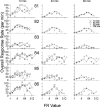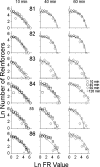The effects of session length on demand functions generated using FR schedules
- PMID: 21547068
- PMCID: PMC3088074
- DOI: 10.1901/jeab.2011.95-289
The effects of session length on demand functions generated using FR schedules
Abstract
In comparing open and closed economies, researchers often arrange shorter sessions under the former condition than under the latter. Several studies indicate that session length per se can affect performance and there are some data that indicate that this variable can influence demand functions. To provide further data, the present study exposed domestic hens to series of increasing fixed-ratio schedules with the length of the open-economy sessions varied over 10, 40, 60, and 120 min. Session time affected the total-session response rates and pause lengths. The shortest session gave the greatest response rates and shortest pauses and the longest gave the lowest response rates and longest pauses. The total-session demand functions also changed with session length: The shortest session gave steeper initial slopes (i.e., the functions were more elastic at small ratios) and smaller rates of change of elasticity than the longest session. Response rates, pauses, and demand functions were, however, similar for equivalent periods of responding taken from within sessions of different overall lengths (e.g., total-session data for 10-min sessions and the data for the first 10 min of 120-min sessions). These findings suggest that differences in session length can confound the results of studies comparing open and closed economies when those economies are arranged in sessions that differ substantially in length, hence data for equivalent-length periods of responding, rather than total-session data, should be of primary interest under these conditions.
Keywords: behavioral economics; closed economy; demand functions; domestic hens; fixed-ratio schedule; open economy; session length.
Figures






Similar articles
-
Demand equations for qualitatively different foods under fixed-ratio schedules: a comparison of three data conversions.J Exp Anal Behav. 2009 Nov;92(3):305-26. doi: 10.1901/jeab.2009.92-305. J Exp Anal Behav. 2009. PMID: 20514164 Free PMC article.
-
Behavioral economics and within-session changes in responding.J Exp Anal Behav. 1999 Nov;72(3):355-71. doi: 10.1901/jeab.1999.72-355. J Exp Anal Behav. 1999. PMID: 10605103 Free PMC article.
-
Reinforcer magnitude and demand under fixed-ratio schedules with domestic hens.Behav Processes. 2014 Mar;103:199-210. doi: 10.1016/j.beproc.2013.12.013. Epub 2014 Jan 3. Behav Processes. 2014. PMID: 24393654
-
Effects of a signaled delay to reinforcement in the previous and upcoming ratios on between-ratio pausing in fixed-ratio schedules.J Exp Anal Behav. 2012 Nov;98(3):295-309. doi: 10.1901/jeab.2012.98-295. J Exp Anal Behav. 2012. PMID: 23144507 Free PMC article.
-
Behavior maintained under fixed-interval and second-order schedules of cocaine or pentobarbital in rhesus monkeys.J Pharmacol Exp Ther. 1982 May;221(2):384-93. J Pharmacol Exp Ther. 1982. PMID: 7077533
Cited by
-
Behavioral economic analysis of the effects of N-substituted benztropine analogs on cocaine self-administration in rats.Psychopharmacology (Berl). 2018 Jan;235(1):47-58. doi: 10.1007/s00213-017-4739-x. Epub 2017 Sep 21. Psychopharmacology (Berl). 2018. PMID: 28932889
-
Economic demand analysis of within-session dose-reduction during nicotine self-administration.Drug Alcohol Depend. 2019 Aug 1;201:188-196. doi: 10.1016/j.drugalcdep.2019.03.033. Epub 2019 Jun 20. Drug Alcohol Depend. 2019. PMID: 31238241 Free PMC article.
References
-
- Ferster C.B, Skinner B.F. Schedules of reinforcement. New York: Appleton-Century-Crofts; 1957.
-
- Foltin R.W. Economic analysis of caloric alternatives and reinforcer magnitude on “demand” for food in baboons. Appetite. 1992;19:255–271. - PubMed
MeSH terms
LinkOut - more resources
Full Text Sources

